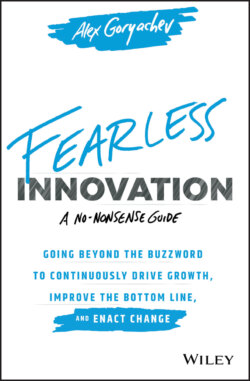Читать книгу Fearless Innovation - Alex Goryachev - Страница 12
Chapter 1 Innovation Is Now or Never
ОглавлениеLet’s talk unicorns. No, not the mythical horse-like creature with one horn that was used as a symbol for Jesus Christ in medieval times, and depending on who you ask, poops rainbows (thanks, Squatty Potty). The unicorns I’m referring to are those privately owned startups valued at a billion dollars or more that are currently taking over the world. As recently as 2015 there were only eighty-two such companies; as of 2018 there were more than 295.1 Fast forward just a year, and by April of 2019 there were 326, with a collective worth of almost $1.1 trillion.2 Many of those were household names, such as 23andMe, Stripe, and SpaceX, along with Uber and Pinterest, which have since gone public. Others you may never have heard of, like the real estate broker Lianjia, the Bitcoin mining application company Bitmain Technologies, or the ByteDance Internet and AI technology company, all three of which happen to be Chinese firms.3
Unicorns are here because of the Fourth Industrial Revolution, which is transforming the way we live, work, and learn, unlike any changes seen before. As a modern society, we’ve come a long way since Britain’s technological advancements in the mid-eighteenth century that led to the First Industrial Revolution, a time that may seem very quaint in comparison to today. Within a hundred years, the world would experience the start of the Second Industrial Revolution, the birth of the assembly line and mass production, not to mention the widespread use of electricity. The Third Industrial Revolution, which seems like just yesterday to many, was another leap forward, with digital manufacturing, automated production, and global Internet connectivity. Organizations had to keep up with technological progress to stay relevant. Those who particularly understood the changes around them were able to shape the world that we live in today.
We have now entered the Fourth Industrial Revolution and are experiencing change at an unprecedented pace, level, and intensity. From augmented reality to genomics, our society is becoming infused with new technologies embedded not just within our homes and workplaces, but even our bodies. We are rapidly blurring the physical and the digital, transforming the way we live and, in some sense, what it even means to be human. This transformation is just in its infancy, as business models will continue to be disrupted and access to technology will increase, along with the ability to develop, launch, and scale new products and services in an ever-shorter time span.
From the cotton spun by the British in the 1760s to the digitization of the twenty-first century, continuous innovation has been necessary for the unicorns of their day to emerge, spearhead change, and prosper. As human societies move forward, so do their businesses. Change always creates opportunities. There’s no telling exactly where this hyper speed of exponential change will lead us, but if we don’t act now, we’ll miss out on the greatest opportunities of our lifetime.
Innovation is urgent, time sensitive, and always present. It’s how we’ve adapted to change and succeeded over the past two and a half centuries, and long before. As with every era behind us, there are new business, social, and economic issues that must be tackled in the Fourth Industrial Revolution, and just as the challenges and opportunities of the past had to be met, so do those of today. If you want your organization to survive, remain competitive, and prosper, then you can’t wait to start taking action. Otherwise, you’ll be forgotten, passed up by the next in line, or blindsided by disruption, because today’s unicorns could be gone tomorrow. In short, innovation never sleeps, and we can’t sleep on it.
Still, despite the obvious need, many organizations lack a clear focus when it comes to innovation or fail to align their efforts with market realities. They “kind of” know that they “must innovate,” yet they are not sure “where” and “why.” Sadly, leadership is missing the big picture as well; most executives don’t even know where their innovation priorities should lie, and by some accounts only 14 percent of executives feel “highly confident” that their organizations are prepared for the changes taking place in the Fourth Industrial Revolution.4 Many of us simply don’t know what to do.
So where do we begin?
